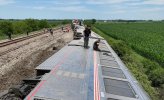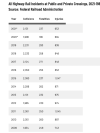DelW
Established Member
- Joined
- 15 Jan 2015
- Messages
- 3,865
Eastbound Southwest Chief suffered major derailment east of Kansas City, following a collision at an open farm crossing. Initial reports stated that the other vehicle involved was a dump truck.
Curiously the lead loco looks to be upright and on the rails, trailing loco and baggage car are leaning at an angle, and all seven Superliner passenger cars are on their sides on the ground.
Amtrak official statement is here:
On June 27 at 12:42 p.m. CT, Southwest Chief Train 4, traveling eastbound on BNSF track from Los Angeles to Chicago, 8 cars and 2 locomotives derailed after striking a truck that was obstructing a public crossing near Mendon, Missouri. There were approximately 275 passengers and 12 crew members onboard.
Curiously the lead loco looks to be upright and on the rails, trailing loco and baggage car are leaning at an angle, and all seven Superliner passenger cars are on their sides on the ground.
Amtrak official statement is here:
On June 27 at 12:42 p.m. CT, Southwest Chief Train 4, traveling eastbound on BNSF track from Los Angeles to Chicago, 8 cars and 2 locomotives derailed after striking a truck that was obstructing a public crossing near Mendon, Missouri. There were approximately 275 passengers and 12 crew members onboard.
Last edited:


![cbc8a4dc-a7d8-4d34-8e1b-752a886afaaa[1].jpg cbc8a4dc-a7d8-4d34-8e1b-752a886afaaa[1].jpg](https://www.railforums.co.uk/data/attachments/112/112465-d850d1341a88e0e69977dd2ed42551c9.jpg)



